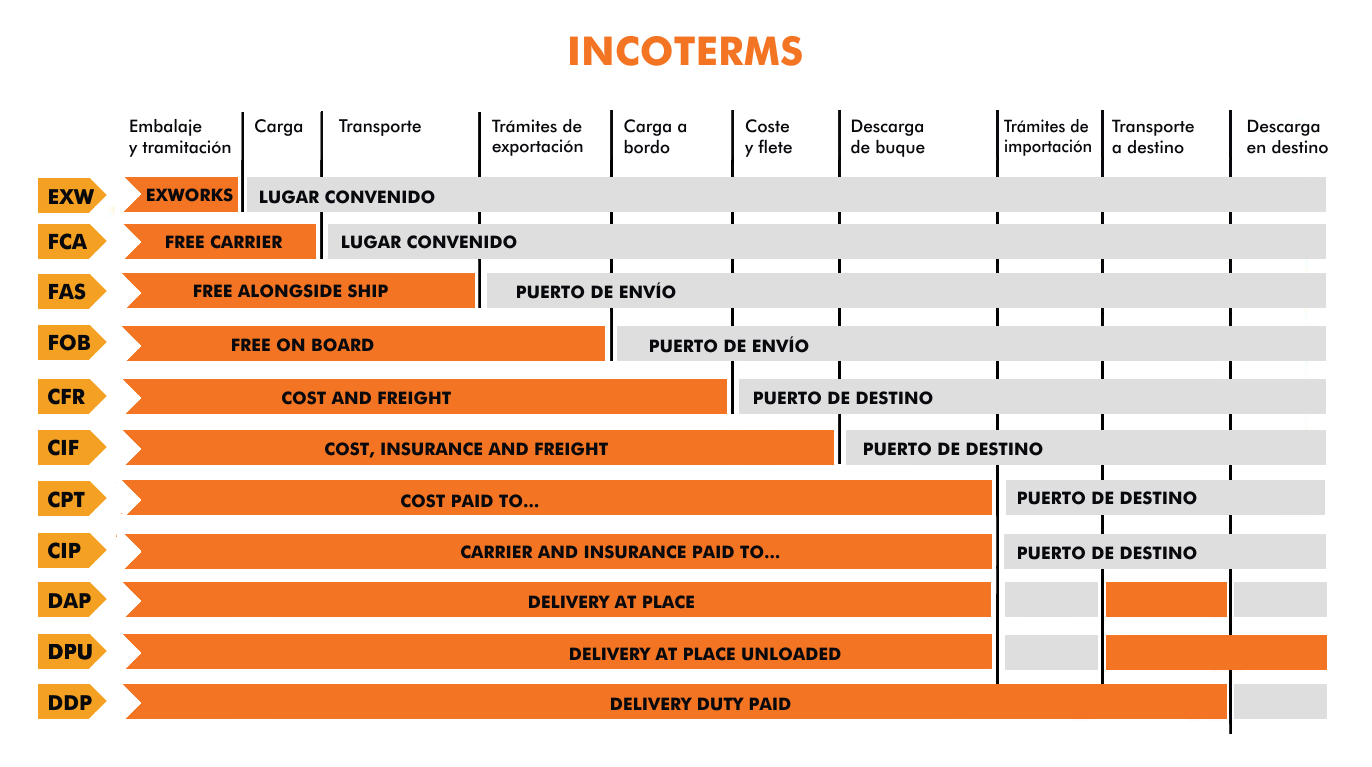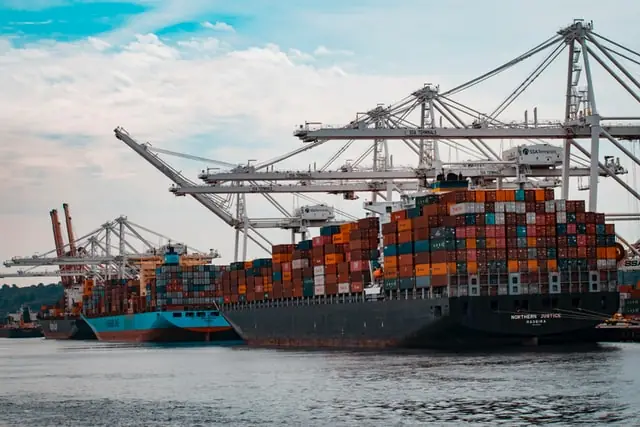¿Qué son los Incoterms?
Los Incoterms son unos términos establecidos para acordar las responsabilidades del exportador y del importador a la hora de realizar una transacción internacional. Estos términos delimitan las condiciones de la operación, tanto a nivel de costes como de la responsabilidad que asume cada parte.
Incoterms es la abreviación de “términos de comercio internacional”. Fueron crearon en 1936, por parte de la Cámara de Comercio Internacional (CCI). Actualmente, constituyen un conjunto de 11 normas. Suponen un requisito indispensable en cualquier factura comercial, reduciendo así el riesgo de confusiones entre las partes, gracias a un detallado de las tareas, riesgos y costes en los que interviene cada una de las partes.
Los mercados avanzan y los Incoterms también se actualizan. Este año 2020, algunos aspectos de ciertos Incoterms han sufrido variaciones. Te las contamos en este artículo.
Tipos de Incoterms
Los Incoterms se pueden clasificar de varias maneras. La más sencilla, pero que revela menos información, es según el medio de transporte utilizado.
Siempre que la mercancía sea enviada por una única vía, marítima o terrestre, se debe escoger entre estos tipos de Incoterms:
- FAS (Free Alongside Ship).
- CFR (Cost and Freight).
- FOB (Free On Board).
- CIF (Cost, Insurance and freight).
Por otro lado, pueden clasificarse en base a si el transporte de la operación es una combinación entre varios medios (marítimo, aéreo, terrestre, ferroviario, etc.). En estos casos, recibe el nombre de multimodal, y puede incluir estos tipos:
- EXW (Ex Works).
- FCA (Free Carrier).
- CPT (Carriage Paid To).
- CIP (Carriage and Insurance Paid To).
- DPU (Delivered at Place Unloaded).
- DAP (Delivered At Place).
- DDP (DDP Delivery Duty Paid).

Ahora veremos la clasificación de los Incoterms según el grupo al que pertenecen:
Grupo E: Entrega en salida.
- EXW: Ex Works. Aquí la mercancía es entregada en las propias instalaciones del vendedor. Es el que implica menores obligaciones, costes y riesgos para el vendedor. Se trata del único Incoterm en el que el vendedor no realiza el despacho de exportación. Por otro lado, al ser el Incoterm que menor nivel de servicio ofrece, se trata también del menos competitivo para el vendedor. Puesto que se pierden partes del proceso, gracias a una buena logística pueden llevar a un mayor ingreso. Es aconsejable para empresas exportadoras con poca experiencia internacional que realizan operaciones de grupaje (cajas y palés) de poco volumen. Cuando se trata de grandes cantidades (contenedores) es preferible optar por el FCA, descrito en el siguiente grupo.
Grupo F: Entrega indirecta.
- FAS: Free Alongside Ship. En este caso, el vendedor entrega la mercancía en el muelle pactado del puerto de carga elegido. El vendedor se encarga del transporte de la mercancía hasta justo antes de que esta suba al barco, pero asume la gestión y los costes de la aduana de exportación. Se suele utilizar para cargas a granel o básicos, que no se embalan y no pueden individualizarse. Se trata, pues, de un Incoterm que se utiliza únicamente para el transporte marítimo. Cuando se utiliza FAS, el comprador, al ser el responsable de la carga de la mercancía en el buque, debe conocer muy bien el funcionamiento del puerto de embarque. El vendedor debe entregar la mercancía al costado del buque, o al alcance de los medios de manipulación de la carga. El comprador tiene la obligación de recoger la mercancía en el puerto designado y en el lugar acordado, siempre que el vendedor se lo haya notificado debidamente en tiempo y forma. El comprador es el que debe contratar el transporte desde el puerto de embarque hasta el lugar de destino final de la mercancía.
- FOB: Free On Board. En este tipo de Incoterm, el vendedor entrega la mercancía en el buque, y el comprador es el que se encarga de contratar el transporte principal. Es de los Incoterms más utilizados. Es preferible su uso cuando el transporte marítimo se realiza en régimen de carga general o cuando su carga es compleja y conlleva riesgos, como puede ser para la maquinaria, de forma que es preferible que su carga la lleve a cabo el vendedor. El vendedor debe suministrar al comprador los documentos que justifican la entrega de la mercancía, además de obtener todos los documentos necesarios para realizar el despacho de exportación (DUA de exportación, certificados, licencias y autorizaciones). Ninguna de las partes tiene la obligación ante la otra de contratar una póliza de seguros de transporte. Con FOB se pueden utilizar tanto medios de pago simples como documentarios. Funciona muy bien con el documentario, puesto que el conocimiento de embarque B/L, además de ser el contrato de transporte, también sirve para transferir la posesión de la mercancía.
- FCA: Free Carrier. Aquí, el vendedor es el que se encarga de entregar la mercancía en un punto acordado del país de origen, o bien en las propias instalaciones del vendedor. Para ello, es necesario que se especifique con claridad el lugar de entrega. Se puede utilizar en cualquier tipo de medio de transporte. Se trata, por tanto, de un Incoterm muy flexible. El vendedor debe realizar los trámites y asumir los costes del despacho de exportación. Por tanto, es responsable de obtener los documentos necesarios para ello. Sin embargo, los del despacho de importación los tramita el comprador. Las partes no tienen la obligación de contratar una póliza de seguro de transporte, pero se aconseja que el comprador contrate un seguro de transporte, al menos para cubrir el transporte internacional.
Grupo C: Entrega indirecta, pero se paga el transporte principal.
- CFR: Cost and Freight. En este Incoterm, el vendedor se hace cargo de todos los costes hasta que la mercancía llegue al puerto de destino, pero la responsabilidad pasa a ser del comprador una vez que la mercancía se carga en el buque. En esta ocasión, es diferente el momento en el que se asume el riesgo del transporte (puerto de embarque) y el punto en el que el vendedor asume los costes del transporte (puerto de destino). Los gastos de terminal en el puerto de embarque y el despacho de exportación son por cuenta del vendedor. En general, no es óptimo para granel, y solo se recomienda para transporte marítimo. La única diferencia con respecto al CIF es que en el CFR el vendedor no tiene la obligación de contratar un seguro de transporte.
- CIF: Cost, Insurance and Freight. Como en el CFR, el vendedor se hace cargo de todos los costes hasta que la mercancía llega al puerto de destino, y la responsabilidad pasa a ser del comprador una vez que la mercancía se carga en el buque. Los gastos de terminal en el puerto de embarque y en el despacho de exportación son por cuenta del vendedor. El vendedor está obligado a contratar un seguro de transporte que cubra, como mínimo, el trayecto desde el puerto de embarque hasta el puerto de destino. El CIF se utiliza exclusivamente en el transporte marítimo, y, generalmente, para carga general o convencional, tanto para productos de consumo de valor medio como productos industriales de valor elevado. Si la mercancía viaja en contenedores, se aconseja utilizar CIP. El CIF ha sido, históricamente, el Incoterm más utilizado, ya que además de situar la mercancía en el país del comprador, el valor CIF es el que se utiliza en la mayoría de las aduanas para aplicar los aranceles e impuestos a la importación, lo cual facilita el despacho aduanero en el país de destino.
- CPT: Carriage Paid To. Aquí, el vendedor se hace cargo de los costes hasta que la mercancía llega al punto convenido en el país de destino. Sin embargo, el riesgo es transferido al comprador desde que la mercancía se le entrega al transportista en el país de origen. Este término se puede utilizar con cualquier tipo de transporte (incluido multimodal). En el caso de que existan varios transportistas sucesivos, el riesgo en el transporte se transmite cuando la mercancía se entrega al primer transportista de la cadena. A diferencia del CIP (que veremos a continuación), el vendedor no tiene la obligación de contratar un seguro de transporte que cubra a la mercancía desde el lugar de entrega hasta el lugar de destino. El vendedor cumple con la obligación de entrega cuando pone la mercancía a disposición del transportista que él mismo ha contratado y en el lugar que ha elegido, generalmente en su país. El riesgo en el transporte de la mercancía se transmite una vez que esta se ha entregado al transportista contratado para trasladarla al destino designado. De haber múltiples transportistas, el riesgo se transfiere en la entrega al primero de ellos.
- CIP: Carriage and insurance Paid. El vendedor realiza la entrega de la mercancía en su propio país, cuando la pone a disposición del transportista que él mismo ha contratado, si bien debe pagar, además, los costes del transporte internacional para llevar la mercancía hasta el lugar de destino en el país comprador. El comprador asume los riesgos que se produzcan una vez que la mercancía ha sido entregada al transportista en el país del vendedor. Bajo el término CIP, el vendedor debe contratar un seguro contra el riesgo que soporta el comprador por la pérdida o daño de la mercancía durante el transporte internacional (cobertura mínima exigida). El vendedor tiene que realizar los trámites y asumir los costes del despacho de aduanas de exportación, no siendo así del despacho de importación que corresponden al comprador.

Grupo D: Entrega directa.
- DPU: Delivered at Place Unloaded. En esta ocasión, el vendedor entrega y descarga la mercancía en el lugar requerido por el comprador en el país de destino. El vendedor se hace cargo del despacho de importación. Este Incoterm entró en vigor en 2020, sustituyendo al DAT. El vendedor tiene que realizar los trámites y asumir los costes del despacho de aduanas de exportación, no así del despacho de importación, que corresponden al comprador. Es factible para cualquier tipo de transporte (terrestre, marítimo o aéreo), y especialmente efectivo para el transporte multimodal.
- DAP: Delivered At Place. El vendedor entrega la mercancía, sin descargar, en el lugar de destino acordado en el país del comprador. La transmisión de riesgos en el transporte se produce en el mismo lugar en el que se entrega la mercancía. Este lugar de entrega puede ser las propias instalaciones del comprador o bien una localización en el interior del país de destino, que no sea terminal de transportes. En el caso de elegir la opción de entregar en una terminal de transportes, se debe usar el tipo DPU. En este Incoterm, el vendedor tiene que realizar los trámites y asumir los costes del despacho de aduanas de exportación, no así los del despacho de importación, que van por cuentan del comprador.
Se trata de un Incoterm muy útil para las ventas entre países de una misma zona económica en las que se quiere entregar la mercancía en las instalaciones del comprador y no hay que realizar despacho de importación. - DDP: Delivered Duty Paid. En este último tipo, el vendedor entrega la mercancía sin descargar del medio de transporte utilizado, en las instalaciones del comprador o en algún punto interior del país del comprador. La transmisión de riesgos en el transporte se produce en el mismo lugar en el que se entrega la mercancía. Este Incoterm es el que representa mayor obligación para el vendedor, ya que asume todos los costes y riesgos de la operación, incluyendo los trámites de importación, hasta entregar la mercancía en el lugar acordado, en el país del comprador. El único coste que no asume el vendedor es la descarga de la mercancía en el lugar de entrega.
La única diferencia del DDP con DAP es que en DDP todos los costes e impuestos del despacho de importación son por cuenta del vendedor. Cuando entre dos países no hay aduanas no debe usarse DDP, sino DAP.
¡Los Incoterms no lo cubren todo!
Cabe destacar que los Incoterms no tratan todos los aspectos de la transacción. Por ello, estas otras cuestiones han de ser acordadas entre exportador e importador de manera independiente al Incoterm escogido:
1. Incumplimientos de contrato.
2. Medios de pago acordados.
3. Derechos de propiedad y transferencia del título de posesión.
4. Fuerza mayor.
Desde Klawter, podemos ayudarte a digitalizar tu empresa para que puedas traspasar fronteras y vender internacionalmente. Gestionamos tu web B2B o B2C, y te ayudamos a promocionarte en el exterior y a escalar tus ventas somos la Agencia de Marketing Digital que necesitas de No pierdas la oportunidad de exportar tus productos. ¡Contacta con nosotros y pídenos presupuesto sin compromiso!






